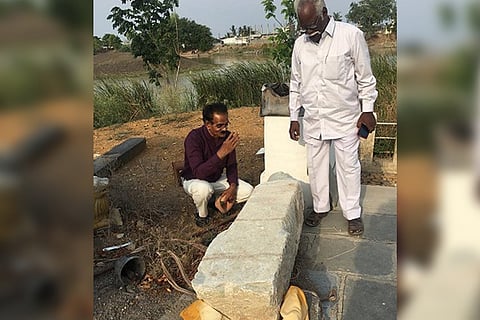

A Buddhist pillar, which is believed to be dating back to 1st century AD, was found in Chandaluru village of Janakavaram Ponguluru mandal of Prakasam district in Andhra Pradesh. According to E Sivanagi Reddy, a Buddhist Scholar and CEO, Cultural Centre of Vijayawada and Amaravati (CCVA), locals of the village had come across the pillar while carrying out work for building a Shiva temple.
“They had kept it wrapped in an old cloth,” said Reddy, who was informed about the pillar by Dr Jyothi Chandramouli, a historian.
Reddy says that the pillar is carved on Palnadu limestone, which is typically used in Buddhist structures. According to him, sculptures of Hindu deities found in the region are typically made of red stone, black stone or other materials, whereas the use of Palnadu limestone unequivocally marks the pillar as a Buddhist construction.
“This is an Aryaka pillar, which is considered noble in Buddhism. It is one of the five pillars that are erected in the four cardinal directions of a Buddhist stupa. The five pillars are meant to represent the five phases in Buddha’s life. These are birth, renunciation, attaining enlightenment, giving the first sermon and Mahaparinirvana,” explained Reddy.
He added that this could mean that there might have been a Buddhist stupa in the area dating back to the Satavahana period. A 1st-century Buddhist site from the same period had been discovered in 2017 on top of a remote hill in Putlagudem village of Guntur district. Another 3rd-century Buddhist sculpture had been found in Guntur last year. There are many Buddhist sites in Andhra Pradesh, including the Ghantasala village in Krishna district.
“Buddhist structures in the area could be from either the Satavahana or the Ikshvaku period. Structures from the Ikshvaku period are typically smaller in size. This particular pillar is from the Satavahana age. The carvings are simple and basic, indicating that it belongs to the Theravada branch of Buddhism,” Reddy said.
Dr Reddy said that a couple of copper plate inscriptions had been found in the nearby region in the past, but this was the first time a Buddhist structure had been found. “There was a Shaivite shrine in the middle of a 35-acre tank called Voora Cheruvu in the village. The locals had been constructing a new Shiva temple near that spot, where the pillar had been found. Even earlier, inscriptions that marked donations made by various rulers to the shrine had been found here. A hero stone, commemorating the death of a man in a local battle was also found. The place has a significant history that must be explored,” said Reddy.